(This post was a participant of “The Archers Blogathon” hosted by The Classic Film & TV Café. To find other wonderful blog entries on this subject please visit the CMBA website.)
The Archers, Michael Powell and Emeric Pressburger, collaborated on eighteen films over a thirty year period (1939-72). Usually, it was Powell who did the bulk of the directing and Pressburger who came up with the story ideas and handled most of the production chores (especially when it came to editing and music). 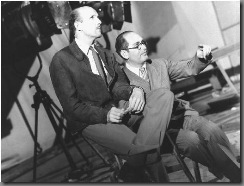 A Matter of Life and Death (1946) was the fifth film they made as the Archers, and is considered by many as their finest. While I don’t share that view (I just love those crazy nuns in Black Narcissus), I do think it is a creatively innovative production that exhibits everything that made the Archer collaboration one of the finest in all of cinema.
A Matter of Life and Death (1946) was the fifth film they made as the Archers, and is considered by many as their finest. While I don’t share that view (I just love those crazy nuns in Black Narcissus), I do think it is a creatively innovative production that exhibits everything that made the Archer collaboration one of the finest in all of cinema.
Initially, A Matter of Life and Death was conceived as a propaganda film to ease the hostility some Brits had toward American military personnel stationed in England during the war. There were complaints that some American soldiers were insensitive to the deprivations the British people endured as a result of rationing and bombing. I suspect if you were watching this in a British theater in 1946 you would have picked up on some of the propagandistic elements, but these were only a small part of a much bigger message about love and art.
Love at first sight is the most common device used by writers of novels and screenplays. Thankfully, the Archers weren’t common and so the lovers of this story are given their own unique love connection. David Niven plays Squadron Leader Peter Carter, a man about to 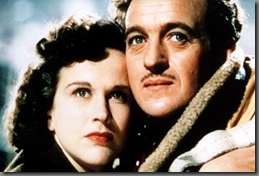 be killed in a fiery airplane crash. Wanting to say goodbye both to his family and the world at large, Peter radios in to give his coordinates so someone can pick up what’s left of him after he jumps without a parachute. He makes contact with June (Kim Hunter), an American radio operator who listens sympathetically to his last words. In that brief conversation they fall in love, which only makes Peter’s coming demise even more tragic. But then there is a literal twist of fate when fog over the English Channel prevents Conductor 71 (Max Goring) from collecting Peter and ushering him into the Other World (that’s its actual name). And, so instead of making his way up a stairway to heaven (which happens to be what the film was called in America), he washes up on a beach near where June is stationed. Their love is affirmed when they meet along the road, and for the rest of the movie they must fight whatever might try to wrest away their happiness.
be killed in a fiery airplane crash. Wanting to say goodbye both to his family and the world at large, Peter radios in to give his coordinates so someone can pick up what’s left of him after he jumps without a parachute. He makes contact with June (Kim Hunter), an American radio operator who listens sympathetically to his last words. In that brief conversation they fall in love, which only makes Peter’s coming demise even more tragic. But then there is a literal twist of fate when fog over the English Channel prevents Conductor 71 (Max Goring) from collecting Peter and ushering him into the Other World (that’s its actual name). And, so instead of making his way up a stairway to heaven (which happens to be what the film was called in America), he washes up on a beach near where June is stationed. Their love is affirmed when they meet along the road, and for the rest of the movie they must fight whatever might try to wrest away their happiness.
What I like most about A Matter of Life and Death is its distinctive artistry. Exhibiting the vastness of the universe and the smallness of human existence must have seemed a strange way to begin a film in 1946, but what an inspired way to begin a supremely unique endeavor. Whenever I watch the opening scenes, with the voiceover of the Universe, I can’t help but think how much of an influence this  must have had on directors like Stanley Kubrick and Terrence Malick. Taking a page out of The Wizard of Oz (1939), the picture was shot both in Technicolor and black and white. Yet, instead of depicting everyday life in black and white and the the fantasy world as a Technicolor paradise, the Archers did something inspired—the Other World is presented in ethereal black and white while real life is shown in color. Cinematographer Jack Cardiff does an excellent job of presenting both worlds as individual realities. His panoramic shots of the Other World’s courtroom are simply masterful. I find it extremely troubling that his work (as well as every element of the film) didn’t merit an Academy Award nomination.
must have had on directors like Stanley Kubrick and Terrence Malick. Taking a page out of The Wizard of Oz (1939), the picture was shot both in Technicolor and black and white. Yet, instead of depicting everyday life in black and white and the the fantasy world as a Technicolor paradise, the Archers did something inspired—the Other World is presented in ethereal black and white while real life is shown in color. Cinematographer Jack Cardiff does an excellent job of presenting both worlds as individual realities. His panoramic shots of the Other World’s courtroom are simply masterful. I find it extremely troubling that his work (as well as every element of the film) didn’t merit an Academy Award nomination.
Alfred Junge’s set design, especially in the Other World, is brilliant. The one image most people remember is the endless escalator to heaven. Its construction was a monumental 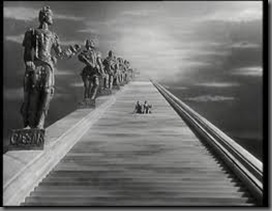 endeavor that took three months to complete, but it was well worth it. Watching Peter and Conductor 71 sitting on the steps and pondering which great mind (usually a passing statue) should represent him in his appeal is almost surreal. The backdrop of endless space is mesmerizing and actually creates a sense of peacefulness. In addition, the design of the Other World’s courtroom is eye-catching, too. The logistics of the massive amount of spectators in the gallery, as well as creating a set design that could hold all of those people, is just mind-boggling. Yet, Junge pulls it off seamlessly.
endeavor that took three months to complete, but it was well worth it. Watching Peter and Conductor 71 sitting on the steps and pondering which great mind (usually a passing statue) should represent him in his appeal is almost surreal. The backdrop of endless space is mesmerizing and actually creates a sense of peacefulness. In addition, the design of the Other World’s courtroom is eye-catching, too. The logistics of the massive amount of spectators in the gallery, as well as creating a set design that could hold all of those people, is just mind-boggling. Yet, Junge pulls it off seamlessly.
Other standout production innovations include the use of freeze-frames, the inventive transitions between Technicolor and black and white, and creatively designed perspective shots. If you’ve seen the film you know that whenever Conductor 71 meets Peter in the real world that time freezes—in his words, “time is a mere tyranny.” The most memorable instance of freeze-frame is when June is playing ping pong with Dr. Reeves (Roger Livesey) and the ball stops in midair while Peter and 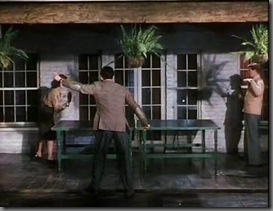 the conductor move about in live action. While this is an interesting scene, it is not what I consider to be the most inspired. That honor belongs to the one where the Archers place the point of perspective behind Peter’s actual eyeball when he goes under anesthesia. The viewer sees what Peter’s eye sees: the medical team, the gas mask, the closing eyelid, then blood vessels, and finally the transition into the black and white Other World. It’s just such an unusual shot design and so different from just about anything that you would see in cinema at that time.
the conductor move about in live action. While this is an interesting scene, it is not what I consider to be the most inspired. That honor belongs to the one where the Archers place the point of perspective behind Peter’s actual eyeball when he goes under anesthesia. The viewer sees what Peter’s eye sees: the medical team, the gas mask, the closing eyelid, then blood vessels, and finally the transition into the black and white Other World. It’s just such an unusual shot design and so different from just about anything that you would see in cinema at that time.
While the overall story is entertaining, I enjoy watching A Matter of Life and Death for its artistic merits. Powell and Pressburger’s cinematic vision is a celebration of creativity and artistry.

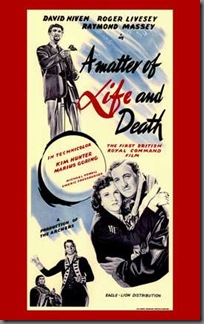
Kim, I have not yet seen this film, but... it sounds like it showcases the horrors of war for both military and civilians. From the pictures it looks like a beautiful film. I will look for it..
ReplyDeleteDawn, I wouldn't classify this as a war film. More of a dramatic love story set at the end of the war.
DeleteKim,
ReplyDeleteHave not seen this but the film sounds fascinating and innovative. Powell and Pressburger seemed to stretch the creative boundaries with each film they made. The comparison to Kubrick and Malick is interesting as well as enticing. Terrific descriptive review here Kim!
John
John, they definitely stretched the boundaries of creativity. I think this is why their films are so unique. The opening scene is very reminiscent of parts of Malick's Tree of Life and Kubrick's 2001.
Delete"A Matter of Life and Death" is the sort of film that has so many enthralling aspects that you can never tire of watching it, because with each viewing you encounter a new perspective in the story and its telling that engages your imagination.
ReplyDeleteYour article gives much to think about for the returning fan or first viewer. "The Archers" and Kim hit a bullseye.
CW, love your play on words! You are right about this being a film from which you never tire.
DeleteKim,
ReplyDeleteI knew nothing about the Powell/Pressburger collaborations until Rick introduced this blogathon. It's been great getting to learn new info about this talented pairing.
Interesting that Matter of Life and Death was made with a focus of propaganda during the war. I'll now keep that in mind when viewing it again.
I did notice the 'freeze frame' but I didn't know what in the world to call it so thanks for that too! : )
An interesting and very information read on a good film.
Page
Page, you have to come out of your wonderfully funny world and watch more P & P! Thanks for reading.
DeleteKim, this is my second favorite Powell & Pressberger film and your excellent review has done its justice. It's an artistic masterpiece in terms of innovative set design, use of color, and (as you wrote) creating two distinctive worlds. And yet, The Archers never let technique overpower emotion, for it's the poignant scenes between David Niven and Kim Hunter that drive the narrative structure. If those didn't resonate, then the film wouldn't work at all. I love your line about how the film "exhibit(s) the vastness of the universe and the smallness of human existence." That theme is reinforced with scene with the camera obscura in Dr. Reeves' office, which turns the residents of the village into small moving figures against a giant backdrop.
ReplyDeleteGood point about the camera obscura--I forgot to mention how awesome that was, too.
DeleteThe world of a Powell & Pressburger film can range from the esoteric to the mundane, but one element links them all: a unique blend of artistic vision and profound storytelling. I was first introduced to this film as part of a double-feature with “The Red Shoes” screened at a local museum. I admit seeing both films in this format spoiled me for watching them on television; the experience simply isn’t the same. I remember being aware that whether the subject was the insular world of ballet or the grandness of the universe, P&P found the means to communicate both in a stunning visual vocabulary and made each a fundamentally personal story.
ReplyDeleteGypsy, you had a treat watching this and The Red Shoes up on the big screen. I suspect you are right on about watching their artistic visions in the format for which they were created.
DeleteKim, I love Powell and Pressberger, yet I have never seen this movie. Your description makes it sound like my kind of film. Your comment "...what an inspired way to begin a supremely unique endeavor..." is intriguing, and makes me eager to see it. I think you are quite right that the way this movie was made must have been inspirational to a filmmaker like Kubrick. The scenes you describe as shown in your post are really beautiful. Wonderful analysis and very well-written article, Kim!
ReplyDeleteHow can one of the biggest fans of The Red Shoes not seen this? LOL! Glad you thought the post was good.
DeleteOne can watch this movie on YouTube.
ReplyDeleteKim, I can't wait to see this one. You've done a great job of making me realize I MUST see this soon since I'm a Powell/Pressburger fan.
ReplyDeleteYes, you MUST!
DeleteKim, I love your analysis of the artistic elements of "A Matter of Life and Death." And you are so right about Jack Cardiff's masterful work. This was a thought-provoking post and I really enjoyed it.
ReplyDeleteCardiff always did great work. He and Toland were in a league of their own. As always, I'm glad you enjoyed my reflection---stop by more often!
Delete"What I like most about 'A Matter of Life and Death' is its distinctive artistry." That's a succinct description of this film's tremendous appeal. It's the most overtly "artistic" picture Powell & Pressburger ever did, even more so than "The Red Shoes" (which for art appeal certainly gives it a run for its money, as does "The Tales of Hoffman"). Michael Powell said it was his favorite of all the P&P films, and you can see the love that went into it. They actually started planning the film in 1944 but had to delay making it because no more Technicolor film stock was available for civilian films for the duration of the war. And they knew that color was essential to their vision of the film. They made "I Know Where I'm Going!" instead but continued to plan this film. Maybe the extra long gestation period contributed to its unique and fully realized visuals and atmosphere.
ReplyDeleteYou mention the b&w Other World sequences. Powell writes that these were actually done in what he calls "monochrome." They were shot on Technicolor film stock then printed without using the color dyes. It was an idea cinematographer Jack Cardiff came up with to give the Other World an especially--well, otherworldly look, that slightly metallic tone of the photography in those sequences.
A great post and some great comments too. Like Caftan Woman, I find this film immensely rewatchable. It's one that for me just gets better and always amazes. And like Rick, I'm a great admirer of that camera obscura sequence.
R.D., I thought it was interesting that they were so set on their vision for this film that they would wait out the war to get the film stock they needed. And, you're right about the monochrome. They wanted to create a Other World that appeared ethereal. Thanks for your insightful comments.
DeleteKim, this is one of the P&P movies I find myself revisiting time and time again...and it's precisely for the reason you state in the piece: the tremendous artistry. I fall in love with that amazing b&w cinematography in A Matter of Life and Death every single time I see the movie (the last time was on TCM, and I was lucky enough to record myself a copy). Jack Cardiff is considered one of the true Technicolor masters, but I think Matter is solid proof that he was no slouch when it came to the monochromatic palette, either. Terrific review!
ReplyDeleteCardiff was a master. P& P were so lucky that they had him as their cinematographer on many of their films.
DeleteGreat review and you are right on all accounts. Technically this is a.masterpiece. Storywise more so-so, but there is an element you failed to mention: the great acting performances. Especially Roger Livesey is outstanding, probably the best I have seen from him so far.
ReplyDeleteYou're right, TS, this is probably Roger Livesey's finest on-screen performance.
Delete